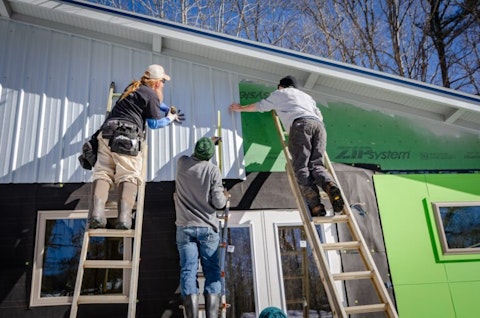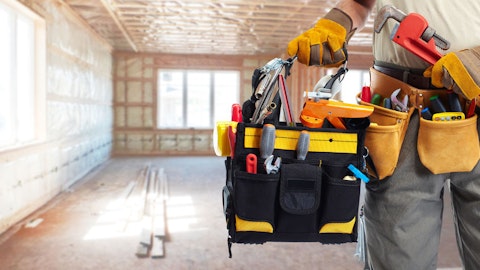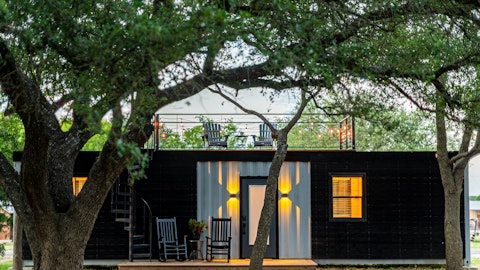D.R. Horton, Inc. (NYSE:DHI) Q3 2023 Earnings Call Transcript July 20, 2023
D.R. Horton, Inc. beats earnings expectations. Reported EPS is $3.9, expectations were $2.79.
Operator: Good morning, and welcome to the Third Quarter 2023 Earnings Conference Call for D.R. Horton, America’s Builder, the largest builder in the United States. At this time, all participants are in a listen-only mode. A question-and-answer session will follow the formal presentation. [Operator Instructions] I will now turn the call over to Jessica Hansen, Vice President of Investor Relations for D.R. Horton.
Jessica Hansen: Thank you, Paul, and good morning. Welcome to our call to discuss our results for the third quarter of fiscal 2023. Before we get started, today’s call includes forward-looking statements as defined by the Private Securities Litigation Reform Act of 1995. Although D.R. Horton believes any such statements are based on reasonable assumptions, there is no assurance that actual outcomes will not be materially different. All forward-looking statements are based upon information available to D.R. Horton on the date of this conference call, and D.R. Horton does not undertake any obligation to publicly update or revise any forward-looking statements. Additional information about factors that could lead to material changes in performance is contained in D.R. Horton’s annual report on Form 10-K and its most recent quarterly report on Form 10-Q, both of which are filed with the Securities and Exchange Commission.
This morning’s earnings release can be found on our website at investor.drhorton.com, and we plan to file our 10-Q early next week. After this call, we will post updated investor and supplementary data presentations to our Investor Relations site on the Presentations section under News & Events for your reference. Now, I will turn the call over to David Auld, our President and CEO.
David Auld: Thank you, Jessica, and good morning. I am pleased to also be joined on this call by Mike Murray and Paul Romanowski, our Executive Vice Presidents and Co-Chief Operating Officers; and Bill Wheat, our Executive Vice President and Chief Financial Officer. For the third quarter, the D.R. Horton team delivered solid results, highlighted by earnings of $3.90 per diluted share. Our consolidated pre-tax income was $1.8 billion on an 11% increase in revenues to $9.7 billion, with a pre-tax profit margin of 18.3%. Our homebuilding return on inventory for the trailing 12 months ended June 30 was 31.8%, and our return on equity for the same period was 24.3%. Despite continued high mortgage rates and inflationary pressures, our net sales orders increased 37% from the prior-year quarter, as the supply of both new home and existing homes at affordable price points is limited and demographics supporting housing demand remain favorable.
We are focused on consolidating market share by supplying more homes to meet homebuyer demand, while maximizing the returns and capital efficiency each of — in each of our communities. With improvements in both labor capacity and availability of materials, our cycle times are decreasing, positioning us to release homes for sale earlier in the construction cycle. We are pleased that we were able to increase our homebuilding starts to 22,900 homes this quarter, which was supported by a 6% sequential increase in our active selling communities. Our homebuilding operating margins are lower than the record high margins we reported last year due to cost inflation and pricing adjustments and incentives we implemented to address homebuyer affordability challenges caused by higher mortgage rates.
However, our margins improved sequentially from the March to June quarter as home prices and incentives have stabilized and some reductions in construction costs are now being realized in our homes closed. We are well-positioned with our experienced operators, diverse product offerings, flexible lot supply, and strong capital and liquidity position to produce and sustain consistent returns, growth and cash flow. We will maintain our disciplined approach to investing capital to enhance the long-term value of our company, including returning capital to our shareholders through both dividends and share repurchases on a consistent basis. Paul?
Paul Romanowski: Earnings for the third quarter of fiscal 2023 decreased 16% to $3.90 per diluted share, compared to $4.67 per share in the prior-year quarter. Net income for the quarter decreased 19% to $1.3 billion on consolidated revenues of $9.7 billion. Our third quarter home sales revenues were $8.7 billion on 22,985 homes closed, compared to $8.3 billion on 21,308 homes closed in the prior year. Our average closing price for the quarter was $378,600, flat sequentially and down 3% from the prior-year quarter. Mike?

Photo by Jens Behrmann on Unsplash
Mike Murray: Our net sales orders in the third quarter increased 37% to 22,879 homes, and order value increased 26% from the prior year to $8.7 billion. Our cancellation rate for the quarter was 18%, flat sequentially and down from 24% in the prior-year quarter. Our average number of active selling communities was up 6% sequentially and up 8% year-over-year. The average price of net sales orders in the third quarter was $381,100, up 2% sequentially and down 8% from the prior-year quarter. To adjust to changing market conditions and higher mortgage rates over the past year, we increased our use of incentives and reduced the sizes of our homes to provide better affordability to homebuyers. Although home prices and incentives have begun to stabilize, we expect to continue utilizing a higher level of incentives as compared to last year.
Our sales volumes can be significantly affected by changes in mortgage rates and other economic factors. However, we will continue to start homes and maintain sufficient inventory to meet sales demand and aggregate market share. Bill?
Bill Wheat: Our gross profit margin on home sales revenues in the third quarter was 23.3%, up 170 basis points sequentially from the March quarter. The decrease in our gross margin from March to June reflects a decrease in incentive costs and lower stick-and-brick costs on homes closed during the quarter. On a per square foot basis, home sales revenues and lot costs were both flat sequentially, while stick-and-brick cost per square foot decreased 4%. As Mike mentioned, we continue to — we expect to continue offering a higher level of incentives as compared to 2022. But due to the recent stabilization in home prices and some reductions in both incentives and construction costs, we expect our homebuilding gross margins to be slightly higher in the fourth quarter compared to the third quarter. Jessica?
Jessica Hansen: In the third quarter, our homebuilding SG&A expenses increased by 6% from last year and homebuilding SG&A expense as a percentage of revenues was 6.7%, up 10 basis points from the same quarter in the prior year. Fiscal year-to-date homebuilding SG&A was 7.2% of revenues, up 30 basis points from the same period last year as we’ve maintained the capacity of our platform to grow market share. Paul?
Paul Romanowski: We started 22,900 homes in the June quarter, up 15% from the March quarter. We ended the quarter with 43,800 homes in inventory, down 22% from a year ago and flat sequentially. 25,000 of our homes at June 30 were unsold, of which 5,700 were completed. For homes we closed in the third quarter, our construction cycle time decreased by over a month from the second quarter, reflecting improvements in the supply chain. We expect to see a further decrease in our cycle time for homes closed in the fourth quarter. We will continue to [ingest] (ph) our homes and inventory and starts pace based on market conditions. Mike?
Mike Murray: Our homebuilding lot position at June 30 consisted of approximately 555,000 lots, of which 25% were owned and 75% were controlled through purchase contracts. 34% of our total owned lots are finished and 53% of our controlled lots are or will be finished when we purchase them. Our capital-efficient and flexible lot portfolio is a key to our strong competitive position. Our third quarter homebuilding investments in lots, land and development totaled $2.2 billion, up 25% from the prior-year quarter and 27% sequentially. Our current quarter investments consisted of $1.2 billion for finished lots, $700 million for land development, and $290 million for land acquisition. Paul?
Paul Romanowski: During the quarter, our rental operations generated $162 million of pre-tax income on $667 million of revenues from the sale of 1,754 single-family rental homes and 230 multi-family rental units. Our rental property inventory at June 30 was $3.3 billion, which consisted of $1.9 billion of single-family rental properties and $1.4 billion of multi-family rental properties. Our rental operations are generating significant increases in both revenues and profits this year, as our platform expands across more markets. For the fourth quarter, we expect our rental revenues to be greater than our third quarter and our rental profit margin to be lower than our third quarter. Bill?
Bill Wheat: Forestar, our majority-owned residential lot development company, reported total revenues of $369 million for the third quarter on 3,812 lots sold with pre-tax income of $62 million. Forestar’s owned and controlled lot position at June 30 was 73,000 lots. 57% of Forestar’s owned lots are under contract with or subject to a right of first offer to D.R. Horton. $270 million of our finished lots purchased in the third quarter were from Forestar. Forestar is separately capitalized from D.R. Horton and had more than $780 million of liquidity at quarter-end, with a net debt to capital ratio of 19.1%. Forestar is uniquely positioned to capitalize on the shortage of finished lots in the homebuilding industry and to aggregate significant market share over the next few years with its strong balance sheet, lot supply and relationship with D.R. Horton. Mike?
Mike Murray: Financial services earned $94 million of pre-tax income in the third quarter on $229 million of revenues, resulting in a pre-tax profit margin of 41.2%. During the quarter, 99% of our mortgage company’s loan originations related to homes closed by our homebuilding operations, and our mortgage company handled the financing for 74% of our buyers. FHA and VA loans accounted for 51% of the mortgage company’s volume. Borrowers originating loans with DHI Mortgage this quarter had an average FICO score of 723 and an average loan to value ratio of 88%. First-time homebuyers represented 56% of the closings handled by our mortgage company this quarter. Bill?
Bill Wheat: Our balanced capital approach focuses on being disciplined, flexible and opportunistic to support and to sustain an operating platform that produces consistent returns, growth and cash flow. We continue to maintain a strong balance sheet with low leverage and significant liquidity, which provides us with flexibility to adjust to changing market conditions. During the first nine months of the year, our cash provided by homebuilding operations was $2.1 billion and our consolidated cash provided by operations was $2.3 billion. At June 30, we had $4.6 billion of homebuilding liquidity, consisting of $2.6 billion of unrestricted homebuilding cash and $2 billion of available capacity on our homebuilding revolving credit facility.
Homebuilding debt at June 30 totaled $2.7 billion, which includes $400 million of senior notes that we redeemed early in July. Our homebuilding leverage was 11.1% at the end of June and homebuilding leverage net of cash was 0.7%. Our consolidated leverage at June 30 was 22%, and consolidated leverage net of cash was 11.2%. At June 30, our stockholders’ equity was $21.7 billion, and book value per share was $64.03, up 23% from a year ago. For the trailing 12 months ended June, our return on equity was 24.3%. During the quarter, we paid cash dividends of $85 million and our Board has declared a quarterly dividend at the same level as last quarter to be paid in August. We repurchased 3.1 million shares of common stock for $343 million during the quarter for a total of 7.7 million shares repurchased fiscal year-to-date for $764 million.
Jessica?
Jessica Hansen: As we look forward, we expect current market conditions to continue with uncertainty regarding mortgage rates, the capital markets and general economic conditions that may significantly impact our business. For the full year, we currently expect to close between 82,800 and 83,300 homes in our homebuilding operations and between 6,500 and 7,000 homes and units in our rental operations. We expect our consolidated revenues for fiscal 2023 to be in a range of $34.7 billion to $35.1 billion. We expect to generate greater than $3 billion of cash flow from operations in fiscal 2023, primarily from our homebuilding operations. We also expect our fiscal 2023 share repurchases to be approximately $1.1 billion, similar to last year.
For the fourth quarter, we currently expect to generate consolidated revenues of $9.7 billion to $10.1 billion, and homes closed by our homebuilding operations to be in the range of 22,800 to 23,300 homes. We expect our home sales gross margin in the fourth quarter to be approximately 23.5% to 24%, and homebuilding SG&A as a percentage of revenues in the fourth quarter to be in the range of 6.7% to 6.8%. We anticipate our financial services pre-tax profit margin of around 30% to 35%, and we expect our income tax rate to be approximately 24.5% in the fourth quarter. We will continue to balance our cash flow utilization priorities among our core homebuilding operations, our rental operations, maintaining conservative homebuilding leverage and strong liquidity, paying an increased dividend and consistently repurchasing shares.
David?
David Auld: In closing, our results and position reflect our experienced teams, industry-leading market share, broad geographic footprint and diverse product offerings. All of these are key components of our operating platform to sustain our ability to produce consistent returns, growth and cash flow, while continuing to aggregate market share. We will maintain our disciplined approach to investing capital to enhance the long-term value of the company, which includes returning capital to our shareholders through both dividends and share repurchases on a consistent basis. Thank you to the entire D.R. Horton team for your continued focus and hard work. This concludes our prepared remarks. We will now host questions.
See also 12 Best Advertising Agency Stocks to Buy and 15 Richest Actors in the World.
Q&A Session
Follow Horton D R Inc (NYSE:DHI)
Follow Horton D R Inc (NYSE:DHI)
Operator: Thank you. At this time, we will be conducting a question-and-answer session. [Operator Instructions] And the first question today is coming from Stephen Kim from Evercore ISI. Stephen, your line is live.
Stephen Kim: Thanks very much guys. Impressive quarter once again. So, congratulations on that. I wanted to talk about your construction — your pace of construction and your goals going forward. You talked about growing your starts this quarter versus last quarter. But when we just look back maybe a year, year and a half ago, there were a couple of quarters where you started even more. You started about 25,000 units a quarter. I wanted to get a sense from you as to whether or not you feel like that’s a level that you could achieve in the near term, and if not why not? And then also if you could talk about whether seasonality is going to be a factor we should be thinking about with respect to your starts cadence?
Paul Romanowski: Yes, Stephen, we have seen, as we talked, about a 30-day reduction in our cycle time and see consistency and improvement as we travel throughout our divisions and seen pretty good balance with our trades and all the supplies that we need to continue with improvement in cycle time. If you look at our starts pace, it did tick up some and stayed pretty consistent with our closings, which is a cadence that we expect to see as we look towards the fourth quarter. Based on our sales pace and the strength of the market, and where we have the lots and the ability to push that up a little bit, we will, but not looking to outpace the market and continue to keep in that cadence and position ourselves for continued growth.
Stephen Kim: Okay. So, it sounds like I didn’t really get a sense for whether 25,000 is a significant figure in your mind. And why is that a level that we couldn’t achieve or revisit? Simply because it wasn’t that long ago where you actually did that for, like I said, two quarters in a row. And then also if I could tack on a second question about your rental platform. You did give some guidance regarding [revs] (ph) being higher, but margins being lower relative to — in 4Q relative to 3Q. Could you talk about your plans for rental inventory in dollars carried on the balance sheet? Where should we be thinking you’re going to take that level of investment, which I think is $3.3 billion, if I’m not mistaken, right now? Is that going to grow meaningfully as we look into 2024 and beyond, or is that a level that you feel comfortable with, maybe even begin to harvest some of that? Thanks.
David Auld: Hey, Steve, as to the 25,000 starts per quarter, we are very focused on increasing — incrementally increasing starts quarter to quarter to quarter. And we believe that as we continue this process, we will consolidate the labor availability capacity. And with labor and material consolidation, our ability to program out our starts and then continue to build the houses and gain efficiency in that process, it’s just an ongoing effort. So, do we have a target out there of we’ve got to get to this number? No. Our target is market by market, flag by flag, how do we consolidate these markets and increase our market share. And just by the nature of doing that, we’re going to get bigger and bigger and bigger. And I’ll let Mike reply to the rental question.
Mike Murray: Hey, Stephen. So, we expect that the margin on the fourth quarter closings in the rental segment will probably have a lower profit margin, largely on the basis of a mix of projects that are delivering between Q3 and then into Q4. A lot of it’s on a cost basis difference between those homes that were built at different times and when they’re delivering.





